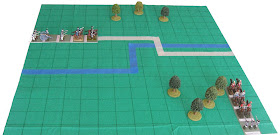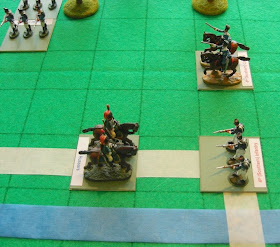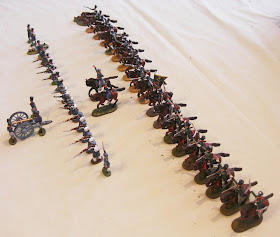The following battle was the opening engagement of the 1820 Cordeguayan Civil War. It was fought using part of my collection of Del Prado 25/28mm Napoleonic wargames figures, and the rules were a hastily lashed-together amalgam of Joseph Morschauser's 'Musket' and 'Frontier' wargames rules.
Scenario
The Southern Army that had been raised by the Constitutionalists was hurrying north to join up with the rest of General Branco's Constitutionalist Army. It comprised:
- 3rd (Southern) Cavalry
- 4th (Southern) Cavalry
- 2nd (Southern) Artillery
- 4th (Southern) Infantry
- 5th (Southern) Infantry
- 6th (Southern) Infantry
News of this movement had reached the ears of President-for-Life General Santa Maria (the leader of the Presidential Army), and he saw it as an opportunity to destroy half of his opponent's army before he moved on the crush the opposition to his 'lawful' regime. He therefore sent a mixed force of cavalry, artillery, and infantry southwards to intercept the Constitutionalists. The force he sent included:
- 3rd Lancers
- 4th Carabineers
- 5th Hussars
- 1st Foot Artillery
- 1st Regular Infantry
- 2nd Regular Infantry
- 6th Militia Infantry
- 7th Militia Infantry
Turn 1
The leading units of each army advanced towards the bridge over the River Blanco.
Turn 2
The Constitutionalists gained the initiative for this turn, and moved their two Cavalry units forward towards the bridge to face to oncoming Presidential forces. The rest of the army followed on as quickly as they could.
The Presidential force responded by moving their Cavalry forward towards the bridge as well, followed by their Regular infantry and Artillery.
Turn 3
The Presidential force gained the initiative this turn, and the Cavalry continued its advance towards the bridge ...
... followed some way behind by the Infantry and the Artillery.
The 3rd (Southern) Cavalry of the Constitutionalist Southern Army (supported by the 4th (Southern Cavalry) charged over the bridge, and attacked the Presidential Army's 3rd Lancers. Whilst this was taking place, the rest of the Constitutionalist Southern Army continued its hurried advance along the road towards the bridge.
The 3rd (Southern) Cavalry engaged the 3rd Lancers in Close Combat ... and dispersed them! They then engaged the Presidential 4th Carabineers ...
... and both units were so badly 'cut up' by the fighting that for all practical purposes they ceased to exist.
Turn 4
The Constitutionalists gained the initiative, and they 4th (Southern) Cavalry advanced across the bridge but did not engage the Presidential 5th Hussars. This allowed the 4th (Southern) Infantry to cross the bridge and turn to engage the 5th Hussars with musket fire.
Despite having only recently been raised, the 4th (Southern) Infantry had obviously been well-drilled, and their volley of musket fire drove off the 5th Hussars, who took no further part in the battle.
The Presidential forces now advanced to meet the oncoming Constitutionalist troops, but as they were out of range, no fire was exchanged between the two sides at this point.
Turn 5
At this crucial point in the battle, whichever side gained the initiative would probably be able to ensure their victory ... and the Constitutionalist side's good luck with continued when they were able to move and fire first!
The vanguard of the Constitutionalist Southern Army (the 4th (Southern) Cavalry and 4th (Southern) Infantry) maintained the positions they had reached during the previous turn whilst the rest of the army advanced towards the bridge.
By doing this, the Constitutionalists had two options that they could choose; either to cross the bridge to extend the existing line of troops facing the Presidential forces or continue their advance along that side of the river, which would enable then to threaten the flank of the Presidential forces whilst being protected by the river from a direct assault by the Presidential infantry.
The Presidential forces did not perceive this danger, and they continued to move the remainder of the troops forward to support the 1st and 2nd Regular Infantry.
Turn 6
This turn the Presidential forces gained the initiative, and the 1st and 2nd Regular Infantry advanced to engage the Constitutionalist troops to their front. The remainder of the Presidential force continued its slow but inexorable advance.
The 2nd Regular Infantry opened fire on the 4th (Southern) Cavalry, but the cavalry survived the encounter. The 1st Regular Infantry were still out of musket range of the 4th (Southern) Cavalry and the 4th (Southern) Infantry.
The 4th (Southern) Cavalry and the 4th (Southern) Infantry responded to the advance of the Presidential forces by withdrawing further out of musket range. This enabled the 2nd (Southern) Artillery to move onto the bridge, where it deployed, ready to fire during the next turn. The 5th and 6th (Southern) Infantry continued to advance along the edge of the river, and would be able to threaten the flank to the advancing Presidential force in the near future.
Turn 7
At this point the Presidential forces realised that they were in no position to win a decisive victory over the Constitutionalists. The loss of their cavalry during the early stages of the battle had deprived them of the only fast-moving troops at their disposal, and the Constitutionalists were already across the bridge and in a strong position to hold off any attacks. The Presidential forces therefore began the slow process of withdrawing.
The Constitutionalists considered the possibility of sending their remaining cavalry in pursuit of the withdrawing enemy forces, but the possibility that this would only lead to the loss of the 4th (Southern) Cavalry for no major gains convinced them that they should leave the Presidential forces to withdraw unmolested. After all, they had inflicted a defeat (albeit a minor one) on the Presidential forces and had shown that President-for-Life General Santa Maria that at least one part of the Constitutionalist Army was not going to run away at the sound of the first musket shot as he had predicted.
Notes and Conclusions
The battle was fought of a 15 square x 15 square grid. The road and river were made from masking tape (some of which seemed to lose its 'stick' during the battle; hence the occasional upturned road or river corner!) and the individually-based trees are typical of the type that can be bought in most model shops that stock items for wargames and/or model railways.
This was a fun little battle to fight, although the outcome was affected by the fact that the Constitutionalists were incredibly lucky with some of their dice throws. The rules were very simple ... and do fit onto a single side of A4 paper (and the print is 12pt, so it is actually readable!).
In retrospect, the movement rates are a bit too fast, and these will be changed in the next draft so as to enable the battles to last slightly longer. The layout of the rules follows the pattern I developed for the most recent (and as yet unpublished) draft of my PORTABLE WARGAME rules. The chart follows the turn sequence (which is displayed in the left-hand column), and at each stage in the turn sequence the various game mechanisms are explained in the right-hand column. This makes the rules very easy to follow and there is no need to have to find what to do in the rules at each stage of the turn sequence.

















































